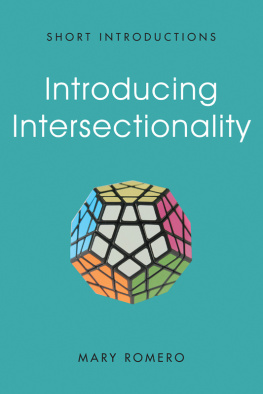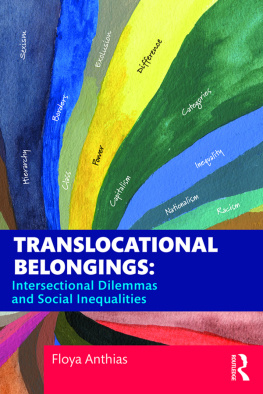
Series page
Short Introductions series
- Nicholas Abercrombie, Sociology
- Michael Bury, Health and Illness
- Raewyn Connell and Rebecca Pearse, Gender 3rd edition
- Hartley Dean, Social Policy 2nd edition
- Lena Dominelli, Introducing Social Work
- Jonathan Gray and Amanda D. Lotz, Television Studies
- Jeffrey Haynes, Development Studies
- Stuart Henry, Social Deviance
- Stephanie Lawson, International Relations 3rd edition
- Chris Rojek, Cultural Studies
- Mary Romero, Introducing Intersectionality
- Karen Wells, Childhood Studies
Copyright page
Copyright Mary Romero 2018
The right of Mary Romero to be identified as Author of this Work has been asserted in accordance with the UK Copyright, Designs and Patents Act 1988.
First published in 2018 by Polity Press
Polity Press
65 Bridge Street
Cambridge CB2 1UR, UK
Polity Press
101 Station Landing
Suite 300,
Medford, MA 02155
USA
All rights reserved. Except for the quotation of short passages for the purpose of criticism and review, no part of this publication may be reproduced, stored in a retrieval system or transmitted, in any form or by any means, electronic, mechanical, photocopying, recording or otherwise, without the prior permission of the publisher.
ISBN-13: 978-0-7456-6366-1
ISBN-13: 978-0-7456-6367-8(paperback)
A catalogue record for this book is available from the British Library.
Library of Congress Cataloging-in-Publication Data
Names: Romero, Mary, author.
Title: Introducing intersectionality / Mary Romero.
Description: Malden, MA : Polity Press, [2017] | Series: Short introductions | Includes bibliographical references and index.
Identifiers: LCCN 2017013088 (print) | LCCN 2017035338 (ebook) | ISBN 9781509525287 (Mobi) | ISBN 9781509525294 (Epub) | ISBN 9780745663661 (hardback) | ISBN 9780745663678 (pbk.)
Subjects: LCSH: Intersectionality (Sociology)
Classification: LCC HM488.5 (ebook) | LCC HM488.5 .R65 2017 (print) | DDC 305dc23
LC record available at https://lccn.loc.gov/2017013088
Typeset in 10 on 12 pt Sabon
by Toppan Best-set Premedia Limited
Printed and bound in Great Britain by CPI Group (UK) Ltd, Croydon
The publisher has used its best endeavours to ensure that the URLs for external websites referred to in this book are correct and active at the time of going to press. However, the publisher has no responsibility for the websites and can make no guarantee that a site will remain live or that the content is or will remain appropriate.
Every effort has been made to trace all copyright holders, but if any have been inadvertently overlooked the publisher will be pleased to include any necessary credits in any subsequent reprint or edition.
For further information on Polity, visit our website:
politybooks.com
Introduction
Intersectionality's focus on social inequality has its roots and development in social justice research and struggle. As an activist project, intersectionality provides analytical tools for framing social justice issues in such a way as to expose how social exclusion or privilege occurs differently in various social positions, and it does this by focusing on the interaction of multiple systems of oppression. It is important to emphasize, however, that the concept is not just about poverty and those of lower socio-economic status. Intersectionality also helps us to understand privilege, riches, and access to higher education. It is a useful concept for understanding what the media have been calling the 1 percent. Access to inherited wealth, admission to Ivy Leagues (especially as a legacy student), and social networks of upward mobility form just as much an intersection as the school-to-prison pipeline and the father-and-son construction union or plumbing business.
In the early 1980s, the phrase race, class and gender was popularly referred to as the holy trinity; a growing number of researchers in the sociology of race and gender called attention to the explanatory power gained by analyzing interactions among these three systems of oppression and privilege. Research demonstrated that the inclusion of systems of power and social location were central to understanding everyday social interactions between individuals in society. Black feminists were at the vanguard of developing this new approach which challenged older theories that analyzed only one social category, for instance gender, without acknowledging that the experience of gender is not the same for a white woman as it is for a Black woman or a woman of color. In studying class inequality, intersectionality insisted that both gender and race power relations were instrumental in comprehending the dynamics of class oppression and privilege. Race, class, and gender had long been treated as variables in sociological research. Intersectionality criticized the notion that these were simply variables to be controlled for. It also criticized the emphasis on one of these power systems, without taking into account the other two, as essentialist.
Clearly, neither racism, sexism, nor classism in the US can be fully explained by, for example, only analyzing the circumstances of elderly married poor Black women in the rural South. Treating the experience of this group as representative of all Black people, or all women, or all poor people is an essentialist view. Critical race scholars contributed to the understanding of systems of class oppression by documenting the ways in which race had always been a primary division in law, economics, and education in the US and all other multicultural countries with histories of colonialism, conquest and immigration. Thus, neither class nor gender dynamics can be explained without figuring out the impact that racial differences have on oppression and/or privilege that individuals and communities experience. Without considering the interaction of systems of oppression and privilege, one might assume that racism, sexism or classism is the same experience regardless of your position in society. As social science came to recognize the different ways members of society experience oppression and privilege, it became important to explain how multiple systems of power interact in different times and locations.
In the past few decades, an increasing number of sociologists have come to accept that an intersectional approach was the key to understanding how inequality, privilege, and oppression worked. More sociologists came to recognize the limitations of one-dimensional approaches to social inequality. Class alone does not explain all aspects of poverty or housing segregation. Gender alone cannot account for wage disparities and occupation segregation. Race by itself does not provide a complete understanding of health disparities or college retention rates. Intersectionality, as an intellectual project, delves deeper into the nuances of social equality by pushing researchers to analyze the various manifestations of inequality. The holy trinity has been complicated by additional power systems: sexuality, ableism, ethnicity, citizenship and age play important roles in social identity and economic status their reproduction and maintenance.
Among the social sciences, sociology has been a leader in developing the concept of intersectionality, both in theory and in research methods. Sociologists began using intersectionality to frame teaching as well as research addressing social inequality. For instance, growing numbers of scholars are contributing to disability studies by examining intersections of race, class, gender and sexuality. Sociologists specializing in the sociology of immigration are incorporating race and gender, to understand how racism has shaped immigration legislation and law enforcement. Research in the sociology of family includes the intersection of systems of inequality sexuality and citizenship, alongside race, class and gender. While intersectional approaches in sociology are gaining wider acceptance, not all fields of study embrace the concept or consider that only focusing on one category is an essentialist approach to the sociological imagination. Many sociologists embracing intersectionality are engaged in conversation with interdisciplinary programs and committed to social justice research.
Next page








